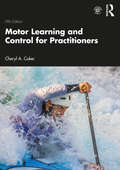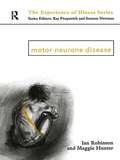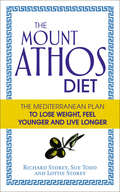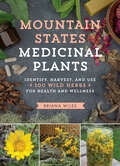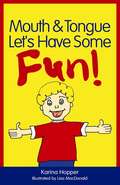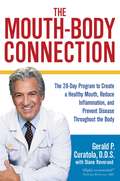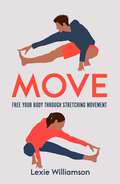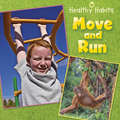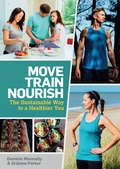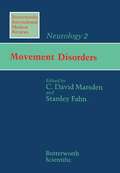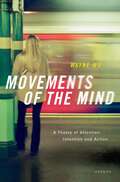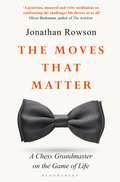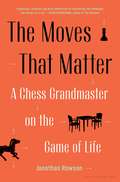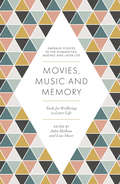- Table View
- List View
Motor Learning and Control for Practitioners
by Cheryl A. CokerWith an array of critical and engaging pedagogical features, the fifth edition of Motor Learning and Control for Practitioners offers the best practical introduction to motor learning available. This reader-friendly text approaches motor learning in accessible and simple terms and lays a theoretical foundation for assessing performance; providing effective instruction; and designing practice, rehabilitation, and training experiences that promote skill acquisition. Features such as Exploration Activities and Cerebral Challenges involve students at every stage, while a broad range of examples helps readers put theory into practice. The book also provides access to a fully updated companion website, which includes laboratory exercises, an instructors’ manual, a test bank, and lecture slides. As a complete resource for teaching an evidence-based approach to practical motor learning, this is an essential text for undergrad and post-grad students, researchers, and practitioners alike who plan to work in the areas of motor learning, motor control, physical education, kinesiology, exercise science, coaching, physical therapy, or dance.
Motor Learning and Control for Practitioners
by Cheryl A. CokerWith an array of critical and engaging pedagogical features, the fifth edition of Motor Learning and Control for Practitioners offers the best practical introduction to motor learning available. This reader-friendly text approaches motor learning in accessible and simple terms and lays a theoretical foundation for assessing performance; providing effective instruction; and designing practice, rehabilitation, and training experiences that promote skill acquisition. Features such as Exploration Activities and Cerebral Challenges involve students at every stage, while a broad range of examples helps readers put theory into practice. The book also provides access to a fully updated companion website, which includes laboratory exercises, an instructors’ manual, a test bank, and lecture slides. As a complete resource for teaching an evidence-based approach to practical motor learning, this is an essential text for undergrad and post-grad students, researchers, and practitioners alike who plan to work in the areas of motor learning, motor control, physical education, kinesiology, exercise science, coaching, physical therapy, or dance.
A Motor Neuron (UEB contracted)
by RnibThis is a diagram of a motor neuron. It shows the cell body on the right, the axons in the middle and the nerve endings on the left. The direction of the nerve impulse is shown as moving from right to left.
Motor Neurone Disease (Experience Of Illness Ser.)
by Margaret Hunter Ian RobinsonMotor Neurone Disease is one of the most difficult conditions to manage medically and socially. A disease which leads to the loss of control of most muscle systems of the body, it has no known cause and no cure. For this reason, clinicians have traditionally been reluctant to reveal the diagnosis to sufferers or their families and the condition has become known as one of the best kept secrets of medical practice. However in recent years a number of organizations have set up to support sufferers and their families and consequently, the public profile of the condition has changed dramatically.Motor Neurone Disease provides an extremely helpful guide to the medical facts relating to the condition and considers the psycho-social effects on sufferers and those who care for them. It will be essential reading for doctors, nurses, social workers, physio-, speech and occupational therapists as well as all those suffering from Motor Neurone Disease, their families and carers.
Motor Neurone Disease
by Margaret Hunter Ian RobinsonMotor Neurone Disease is one of the most difficult conditions to manage medically and socially. A disease which leads to the loss of control of most muscle systems of the body, it has no known cause and no cure. For this reason, clinicians have traditionally been reluctant to reveal the diagnosis to sufferers or their families and the condition has become known as one of the best kept secrets of medical practice. However in recent years a number of organizations have set up to support sufferers and their families and consequently, the public profile of the condition has changed dramatically.Motor Neurone Disease provides an extremely helpful guide to the medical facts relating to the condition and considers the psycho-social effects on sufferers and those who care for them. It will be essential reading for doctors, nurses, social workers, physio-, speech and occupational therapists as well as all those suffering from Motor Neurone Disease, their families and carers.
The Mount Athos Diet: The Mediterranean Plan to Lose Weight, Feel Younger and Live Longer
by Lottie Storey Richard Storey Sue ToddFor centuries, the monks of Mount Athos have enjoyed long lives, healthy bodies and calm minds thanks to their unique diet and lifestyle. Now you too can discover the secrets of good nutrition from this ancient community in a remarkable new diet book.In The Mount Athos Diet, you'll follow the intermittent diet that keeps the monks slim, youthful and largely free from disease. The diet is made up of three easy-to-follow patterns throughout the week:- Three fasting days full of delicious fruits and vegetables from nature's larder- Three moderation days to enjoy the best of the Mediterranean, including olive oil, fish and even red wine- One feast day to completely indulge in whichever foods you likeWith a simple diet plan, recipes, menu planners and tips on how to adapt the diet, plus guidance on exercise, meditation and emotional wellbeing, The Mount Athos Diet promises to transform your body and mind to help you lose weight, feel fitter and live longer.
Mountain States Medicinal Plants: Identify, Harvest, and Use 100 Wild Herbs for Health and Wellness
by Briana WilesForagers and herbalists in the Mountain States will adore this indispensable guide to finding, identifying, and using the medicinal plants that grow wild, local, and natural.
Mouse and the Storm: Children’s reflexology to reduce anxiety and help soothe the senses (PDF)
by Melissa Muldoon Susan QuayleMouse and her animal friends are rudely disrupted from the comfort of their homes by a big storm! Waking up away from home, together they must find their way back despite feeling scared and lost. Written in rhyme along with easy-to-follow diagrams and instructions for giving simple hand reflexology to a child, this book will help parents soothe children, especially those who experience anxiety or have sensory regulation difficulties. Beautiful illustrations accompany the reflexology techniques which are easy to use to provide a calming experience to a child. No prior reflexology knowledge is required.
Mouse's Best Day Ever: Children's Reflexology to Soothe Sore Teeth and Tums (PDF)
by Melissa Muldoon Sally Earlam Spiros Dimitrakoulas Susan QuayleMouse and Mole head to Squirrel's tree for tea, but as the weather turns stormy they have to find shelter. Will the rain and wind dampen their day? Join them as they find fun and laughter and have the BEST DAY EVER! With delightfully engaging rhymes and illustrations, this book features easy-to-follow diagrams and instructions for giving basic reflexology to a child. The reflexology techniques included relax and soothe, and they offer a gentle remedy to the symptoms of constipation, colic and teething in babies and young children. Written by a specialist maternity reflexologist, this book can also be used to help strengthen the bonding process between parent (or carer) and child. No prior reflexology knowledge is required.
The Mouse's House: Children's Reflexology for Bedtime or Anytime (PDF)
by Melissa Muldoon Susan QuayleMouse finds a new house and calls upon her woodland friends to help her to make it a cosy home, but will it be ready in time for winter? Combining reflexology with delightfully engaging rhymes and illustrations, this book features easy-to-follow diagrams and instructions for giving basic reflexology to a child during a bedtime (or anytime) story. This unique book, written by a specialist maternity reflexologist, uses this non-invasive complementary therapy to help strengthen the bonding process between parent (or carer) and child and offers a gentle remedy for problems such as sleep difficulties, anxiety and mild pain. No prior reflexology knowledge is required.
The Mouse's House: Children's Reflexology for Bedtime or Anytime
by Susan Quayle Melissa MuldoonMouse finds a new house and calls upon her woodland friends to help her to make it a cosy home, but will it be ready in time for winter? Combining reflexology with delightfully engaging rhymes and illustrations, this book features easy-to-follow diagrams and instructions for giving basic reflexology to a child during a bedtime (or anytime) story. This unique book, written by a specialist maternity reflexologist, uses this non-invasive complementary therapy to help strengthen the bonding process between parent (or carer) and child and offers a gentle remedy for problems such as sleep difficulties, anxiety and mild pain. No prior reflexology knowledge is required.
Mouth and Tongue Let's Have Some Fun!
by Karina HopperLearning new facial expressions and mouth movements can be great fun, just ask Sam!Moving the tongue and mouth in different ways is very effective for strengthening facial muscles and aiding speech development, so this simple picture book is a must for anyone worried that a child's speech is showing signs of delay. Children will love copying Sam and Timmy Tongue's funny faces and improve their facial strength and dexterity in the process. This book will be an invaluable resource for any parent, teacher or professional looking to help a child with delayed speech.
The Mouth-Body Connection: The 28-Day Program to Create a Healthy Mouth, Reduce Inflammation and Prevent Disease Throughout the Body
by Gerald P. Curatola Diane ReverandAcclaimed oral health expert and wellness pioneer, Dr. Gerry Curatola, explores the bi-directional relationship between the health of your mouth and your body, and provides a groundbreaking program for creating a healthy mouth that will help maintain a healthy body. The mouth acts as mirror and a gateway and reflects what is happening in the rest of your body and the health of your mouth appears to have a profound impact on the rest of your body. Chronic, low-grade oral disease is a major source of inflammation throughout your body, which can sometimes result in serious systemic problems, including cardiovascular disease, type 2 diabetes, obesity, and premature birth. The Mouth-Body Connection educates the reader on the natural ecology of the mouth. The oral microbiome consists of communities of 20 billion microorganisms of more than six hundred types-keeping these communities balanced is the key to well-being. Dr. Curatola's program, thirty years in the making, helps to restore microbiome balance and reduce health-destroying inflammation. The Curatola Care Program fosters a healthy oral microbiome by means of diet, supplements, exercise, and stress reduction. Four weeks of meal plans and fifty delicious recipes will convince you that eating for balance can be a treat. There are supplement schedules for each stage, two high-intensity band workouts that take only 15 minutes twice a week, relaxation techniques, and yoga postures to fight inflammation.In just four weeks, you will reboot your body and begin to take control of your health. Best of all, your brilliant smile will prove that you have never felt better. p.p1 {margin: 0.0px 0.0px 0.0px 0.0px; font: 12.0px Geneva} p.p2 {margin: 0.0px 0.0px 0.0px 0.0px; text-indent: 36.0px; font: 12.0px Geneva} p.p3 {margin: 0.0px 0.0px 0.0px 0.0px; text-indent: 36.0px; font: 12.0px Geneva; min-height: 16.0px} p.p4 {margin: 0.0px 0.0px 0.0px 0.0px; font: 12.0px Geneva; min-height: 16.0px} span.s1 {font: 12.0px Symbol}
The Mouth-Body Connection: The 28-Day Program to Create a Healthy Mouth, Reduce Inflammation and Prevent Disease Throughout the Body
by Gerald P. Curatola Diane ReverandAcclaimed oral health expert and wellness pioneer, Dr. Gerry Curatola, explores the bi-directional relationship between the health of your mouth and your body, and provides a groundbreaking program for creating a healthy mouth that will help maintain a healthy body.The mouth acts as mirror and a gateway and reflects what is happening in the rest of your body and the health of your mouth appears to have a profound impact on the rest of your body. Chronic, low-grade oral disease is a major source of inflammation throughout your body, which can sometimes result in serious systemic problems, including cardiovascular disease, type 2 diabetes, obesity, and premature birth. The Mouth-Body Connection educates the reader on the natural ecology of the mouth. The oral microbiome consists of communities of 20 billion microorganisms of more than six hundred types-keeping these communities balanced is the key to well-being. Dr. Curatola's program, thirty years in the making, helps to restore microbiome balance and reduce health-destroying inflammation. The Curatola Care Program fosters a healthy oral microbiome by means of diet, supplements, exercise, and stress reduction. Four weeks of meal plans and fifty delicious recipes will convince you that eating for balance can be a treat. There are supplement schedules for each stage, two high-intensity band workouts that take only 15 minutes twice a week, relaxation techniques, and yoga postures to fight inflammation.In just four weeks, you will reboot your body and begin to take control of your health. Best of all, your brilliant smile will prove that you have never felt better.
Move: Free your Body Through Stretching Movement
by Lexie WilliamsonAn aspirational and inclusive guide to 'freeing up' the body through dynamic movement, focusing on the 'feel-good' benefits of stretching. Aside from improved flexibility, these include better posture ('standing tall'), reduced back strain and the mental 'brain boost' that results from increased blood flow during movement.Move explores dynamic stretching, or slow flowing movement. This is the most effective way to increase joint range of motion (the 'Move it or Lose it' principle) thereby allowing us to move comfortably and freely, as we were born to do. Uniquely designed to explore just six key move sequences each containing the main planes of motion: flexion (forward bending), extension (back bending), side bending and rotation. They can be used either as five-minute stand-alone routines, or tagged together to form a longer flexibility sequence as you might experience in a flow yoga class. Rather than the common format used in stretching books of detailing the science of stretching, followed by a list of exercises, this book puts the six key moves centre stage and spends most of the book explaining and refining them. The emphasis is on simplicity. There are six key move routines: two lying, one cross-legged, one all fours, one lunge-based and the final one standing. Each routine has just four variations within it. This means the reader does not have to keep switching positions. The book avoids using yoga jargon or sports science language and instead focuses on the 'feel-good' benefits of stretching. In short, the book allows us all you to stretch ourselves happy.
Move: Free your Body Through Stretching Movement
by Lexie WilliamsonAn aspirational and inclusive guide to 'freeing up' the body through dynamic movement, focusing on the 'feel-good' benefits of stretching. Aside from improved flexibility, these include better posture ('standing tall'), reduced back strain and the mental 'brain boost' that results from increased blood flow during movement.Move explores dynamic stretching, or slow flowing movement. This is the most effective way to increase joint range of motion (the 'Move it or Lose it' principle) thereby allowing us to move comfortably and freely, as we were born to do. Uniquely designed to explore just six key move sequences each containing the main planes of motion: flexion (forward bending), extension (back bending), side bending and rotation. They can be used either as five-minute stand-alone routines, or tagged together to form a longer flexibility sequence as you might experience in a flow yoga class. Rather than the common format used in stretching books of detailing the science of stretching, followed by a list of exercises, this book puts the six key moves centre stage and spends most of the book explaining and refining them. The emphasis is on simplicity. There are six key move routines: two lying, one cross-legged, one all fours, one lunge-based and the final one standing. Each routine has just four variations within it. This means the reader does not have to keep switching positions. The book avoids using yoga jargon or sports science language and instead focuses on the 'feel-good' benefits of stretching. In short, the book allows us all you to stretch ourselves happy.
Move and Run (Healthy Habits #3)
by Hachette Children'S Books'Healthy Habits: Move and Run' describes how animals use their bodies to move about in different ways. It highlights the importance of eating well and taking lots of exercise to keep our bodies strong and healthy.This book is part of a friendly series that helps young readers to explore the differences and similarities between us and the animal world and to learn some healthy habits along the way. Illustrated with stunning photographs and featuring tips and advice for healthy living, this series will engage as well as inform.
Move, Train, Nourish: The Sustainable Way to a Healthier You
by Dominic Munnelly Gráinne ParkerDominic and Gráinne are a husband-and-wife team who understand that, although health and fitness are largely sold to us by younger people, they are not the preserve of the young. Being healthy is fundamental to every stage of life. Their holistic approach integrates all aspects of wellness: mobility, exercise, sleep, nutrition and stress management. By the time they met, Gráinne had tragically lost her first husband to sudden adult death syndrome. In the aftermath of this trauma, she moved to Rome to study cooking and rekindled her love of yoga. By reconnecting with her body, she slowly began to heal her soul. Meanwhile, Dominic’s devotion to education and training had left him well read and in great shape but lacking the emotional intelligence needed to give him balance. When their paths crossed, they brought harmony to each other's lives. They both bring their own passion, life experience and expertise to this sensible, balanced guide to physical and mental well-being. Explaining why mobility is the foundation of fitness, they provide key stretches that will allow you to act as your own physio, regaining your childhood movement pattern so you can get the most out of the clearly illustrated workout plans. Showing that healthy eating doesn't have to be something you do until you fall off the wagon, they teach the fundamentals of good nutrition and provide healthy recipes that will allow the whole family to enjoy tasty food while eating well for life. From improving your sleep to developing resilience to stress, they also share tips for self-care to help you cope in times of pressure and feel calmer every day. This is a book for everyone who wants a complete guide to moving well, training well, and nourishing your body both inside and out.
Movement Disorders: Neurology
by Stanley Fahn C. David MarsdenNeurology, Volume 2: Movement Disorders is a part of an international series of critical reviews of topics in neurology. This volume focuses on Parkinsonism and dyskinesia, a condition characterized by abnormal involuntary movements. Organized into 18 chapters, this book first elucidates the problems, causes, pathology, brain neurotransmitter changes and receptors, depression, dementia, fluctuations of disability, and treatment of Parkinson's disease. Subsequent chapters then explore the problems, controversies, and surgical approaches involved in certain dyskinesias. The role of dopamine receptors in movement disorders is also explored. This book will be valuable to neurologists-in-training, as well as to those in research field or in practice in this field of interest. The book's clinical content will help in the management of patients with movement disorders.
Movements of the Mind: A Theory of Attention, Intention and Action
by Wayne WuMovements of the Mind is about what it is to be an agent. Focusing on mental agency, it integrates multiple approaches, from philosophical analysis of the metaphysics of agency to the activity of neurons in the brain. Philosophical and empirical work are combined to generate concrete explanations of key features of the mind. The book should be relevant and accessible to philosophers and scientists interested in mind and agency. Wu argues that actions have a core psychological structure where attention plays a necessary role in guiding the agent's response and intentions function as memory for work, a practical memory. Attention and memory are accordingly central parts of an agent's intentionally doing things. These claims are supported by synthesizing philosophical and empirical work to produce a theory of intention and attention in action. The account explains three phenomena of current philosophical interest: (a) the basis of positively and negatively biased action where attention often leads to implicit bias, (b) the dynamics of deductive reasoning as the focusing of a thinker's cognitive attention and the development of cognitive skills, and (c) the psychology of introspective access to conscious perceptual experience, making clear when introspection can intelligibly fail and when it can succeed. The book provides a theory of agency, whether human or non-human, along with technical notions of automaticity and control, a theory of attention as selection to guide behavior, an account of intention as memory whose dynamics are revealed in empirical investigation of working memory, explications of sustained attention and vigilance, an explanation of biased behavior driven by biases on attention, normative aspects of attention as a skill, the role of learning in cognitive skill, a theory of deduction as a sharpening of attention, and a psychologically plausible model of introspection that speaks to its accuracy and reliability.
Movements of the Mind: A Theory of Attention, Intention and Action
by Wayne WuMovements of the Mind is about what it is to be an agent. Focusing on mental agency, it integrates multiple approaches, from philosophical analysis of the metaphysics of agency to the activity of neurons in the brain. Philosophical and empirical work are combined to generate concrete explanations of key features of the mind. The book should be relevant and accessible to philosophers and scientists interested in mind and agency. Wu argues that actions have a core psychological structure where attention plays a necessary role in guiding the agent's response and intentions function as memory for work, a practical memory. Attention and memory are accordingly central parts of an agent's intentionally doing things. These claims are supported by synthesizing philosophical and empirical work to produce a theory of intention and attention in action. The account explains three phenomena of current philosophical interest: (a) the basis of positively and negatively biased action where attention often leads to implicit bias, (b) the dynamics of deductive reasoning as the focusing of a thinker's cognitive attention and the development of cognitive skills, and (c) the psychology of introspective access to conscious perceptual experience, making clear when introspection can intelligibly fail and when it can succeed. The book provides a theory of agency, whether human or non-human, along with technical notions of automaticity and control, a theory of attention as selection to guide behavior, an account of intention as memory whose dynamics are revealed in empirical investigation of working memory, explications of sustained attention and vigilance, an explanation of biased behavior driven by biases on attention, normative aspects of attention as a skill, the role of learning in cognitive skill, a theory of deduction as a sharpening of attention, and a psychologically plausible model of introspection that speaks to its accuracy and reliability.
The Moves that Matter: A Chess Grandmaster on the Game of Life
by Jonathan RowsonFrom Grandmaster and three-time British Chess Champion, a passionate exploration of what it means to find fulfilment and lasting value in lifeChess is just a game in the way that the heart is just a muscleLong known as a cut-throat metaphor for warfare or business, this ancient game of strategy and self-discipline is revealed to be a singularly powerful metaphor for the challenges, thrills, and set-backs that invest our daily lives with meaning and complexity.Jonathan Rowson's competitive success as a Grandmaster and work as an applied philosopher have given him a unique perspective on why the game of chess is more important than ever for understanding the conflicts and uncertainties of the modern world. In sixty-four witty and addictive vignettes, Rowson takes us on an exhilarating tour of his 'lessons for the game of life', from the psychology of gang violence, to the aesthetics of cyborgs, the beauty of technical details, and the final endgame of death itself. Chess emerges as a rich and endlessly suggestive way of thinking about the desires that shape the world around us.The Moves That Matter celebrates the redeeming power of intense concentration, but it also offers a humane and compassionate account of how every individual exists as part of a wider community. Jonathan Rowson reveals, one move at a time, what it means to love or care deeply in the intricate game of life.
The Moves That Matter: A Chess Grandmaster on the Game of Life
by Jonathan RowsonA chess grandmaster reveals the powerful teachings this ancient game offers for staying present, thriving in a complex world, and crafting a fulfilling life. Refined and perfected through 1,500 years of human history, chess has long been a touchstone for shrewd tacticians and master strategists. But the game is much more than just warfare in miniature. Chess is also an ever-shifting puzzle to be solved, a narrative to be written, and a task that demands players create their own motivation from moment to moment. In other words, as Grandmaster Jonathan Rowson argues in this kaleidoscopic and inspiring book, there are ways to see all of life reflected in those 64 black and white squares. Taking us inside the psychologically charged world of chess's global elite, Rowson mines the game for its insights into sustaining focus, quieting our inner saboteur, making tough decisions, overcoming failure, and more. He peels back the beguiling logic of chess to reveal the timeless wisdom underneath. This exhilarating tour ranges from learning how to love our mistakes to considering why people are like trees; from the mysteries of parenting to the beauty of technical details, to the endgame of death. Throughout, chess emerges as a powerful and accessible metaphor for the thrills and setbacks that fill our daily lives with meaning and beauty.
Movies, Music and Memory: Tools for Wellbeing in Later Life (Emerald Studies in the Humanities, Ageing and Later Life)
by Julia Hallam Lisa ShawPresenting research findings from recent studies which use innovative, creative approaches, including pilot projects led by the authors in the UK and Brazil, this book provides an accessible, timely, practical and jargon-free overview of how music and films are currently used in nursing homes, dementia wards and day-care centres for the older population. Drawing on the expertise of researchers, health care professionals and carers, the book looks at the experience of both stakeholder groups - carers and the cared-for. It provides useful, unique insights into how we might tackle the pressing real-world challenge posed by an ageing global population and attendant increase in the number of those living with dementia. Complemented by a downloadable ‘best-practice’ toolkit that contains tips and materials relating to film- and music-related activities for use by carers (both professionals and family members), this book fills a gap in the market by providing both academic responses and practical solutions to a critical global challenge.
Movies, Music and Memory: Tools for Wellbeing in Later Life (Emerald Studies in the Humanities, Ageing and Later Life)
by Lisa ShawPresenting research findings from recent studies which use innovative, creative approaches, including pilot projects led by the authors in the UK and Brazil, this book provides an accessible, timely, practical and jargon-free overview of how music and films are currently used in nursing homes, dementia wards and day-care centres for the older population. Drawing on the expertise of researchers, health care professionals and carers, the book looks at the experience of both stakeholder groups - carers and the cared-for. It provides useful, unique insights into how we might tackle the pressing real-world challenge posed by an ageing global population and attendant increase in the number of those living with dementia. Complemented by a downloadable ‘best-practice’ toolkit that contains tips and materials relating to film- and music-related activities for use by carers (both professionals and family members), this book fills a gap in the market by providing both academic responses and practical solutions to a critical global challenge.
